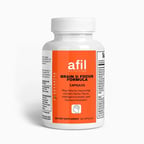Copper Oxide
Copper oxide intolerance often results from excessive exposure through water, cookware, industrial products, or personal care items. Reducing contact, balancing copper intake, and supporting detoxification pathways can help manage symptoms and maintain overall health.
🌿 What is Copper Oxide?
Copper oxide is a chemical compound derived from copper, commonly used in industrial applications, electronics, coatings, and even some dietary supplements. While copper is an essential nutrient, excessive exposure to copper oxide—especially through inhalation, ingestion, or skin contact—can lead to intolerance or toxicity. Symptoms may include digestive issues, skin irritation, respiratory discomfort, or neurological effects in sensitive individuals.
🤔 Why Do I Have an Intolerance to Copper Oxide?
Copper oxide intolerance may result from excessive exposure, sensitivity, or difficulties with copper metabolism:
• Metal sensitivity – Individuals with metal allergies may experience skin irritation or allergic reactions upon contact.
• Inhalation exposure – Industrial workers handling copper oxide dust or fumes may develop respiratory irritation or lung discomfort.
• Copper accumulation – Prolonged exposure from drinking water, cookware, or supplements may lead to copper overload.
• Gastrointestinal distress – Ingesting high levels of copper from contaminated water or supplements can cause nausea, vomiting, or diarrhea.
• Impaired detox pathways – Some individuals struggle to regulate copper levels due to genetic factors or liver dysfunction.
🛠️ What Can I Do About It?
• Limit exposure – Reduce contact with copper oxide in industrial settings, coatings, and metal-based products.
• Use filtered water – If your home has copper plumbing, install a high-quality water filtration system to reduce copper content.
• Choose safe cookware – Avoid uncoated copper pots and pans, which can leach copper into food.
• Monitor supplement intake – Be cautious with multivitamins or mineral supplements that contain copper.
• Support detoxification – Optimize liver function with nutrients that help process excess copper.
💊 Supportive Options
- Zinc – Helps regulate copper balance and prevent excess accumulation.

- Vitamin C – Aids in copper metabolism and protects against oxidative stress.

- NAC (N-Acetyl Cysteine) – Supports liver detox pathways and reduces inflammation.
- Milk thistle – A natural liver support herb that assists in heavy metal detoxification.

- Probiotics – Helps maintain gut health and improves mineral absorption balance.

🌟 Why Might I React to Copper Oxide but Not Other Metals?
• Copper oxide is highly reactive – It can easily dissolve in water, increasing exposure through ingestion.
• Higher absorption rate – The body absorbs copper more efficiently than some other metals, leading to potential overload.
• Metal sensitivity varies – Some individuals tolerate iron or zinc but react strongly to copper-based compounds.
• Copper is a bioaccumulative metal – Excessive intake can build up over time, leading to long-term toxicity.
🍽️ Common Exposure Sources
• Copper plumbing and drinking water
• Industrial coatings, paints, and electronic components
• Metal alloys used in coins, jewelry, and household items
• Copper cookware and food storage containers
• Agricultural fungicides and pesticides
🍽️ Alternatives (if tolerated)
• Stainless steel or ceramic cookware
• Reverse osmosis or carbon-block water filters
• Hypoallergenic jewelry made from titanium or surgical-grade stainless steel
• Natural, non-copper-based fungicides and pesticides
.png?width=100&height=75&name=AFIL%20Logo%20(1).png)